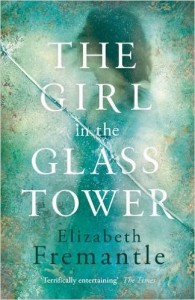Elizabeth Fremantle is the author of the Tudor Trilogy, ‘Queen’s Gambit, Sisters of Treason and Watch the Lady.’
Her new novel, ‘The Girl in the Glass Tower’ is published in the UK and the USA today.
To buy her new novel in the UK:
To buy in the USA:
Follow Elizabeth Fremantle on Social Media:
Elizabeth’s website: www.elizabethfremantle.com
Twitter: @lizfremantle
Facebook: Elizabeth Fremantle
Many thanks to Elizabeth for answering my questions.
Why did you choose to write about Arbella Stuart?
Arbella as presumed heir to Elizabeth, seemed an obvious choice for me, as I was able to explore the final months of the Tudor dynasty through her. My previous three novels had all dealt in their own way with the succession, which had become a critical political issue by the end of the century. My previous novel, Watch the Lady, explored how it came to be that James I took the throne and Arbella’s was an unspoken story in that narrative.
But most of all it was Arbella herself. There are few women of the period for whom we have such an extensive archive of correspondence and through her letters I was able to understand what a complex, intelligent, determined and self-destructive woman she was and also the extent of the tragedy in her life. Her extraordinary story of escape resonated deeply with me, and I hoped it would also do so for my readers.
Does ‘The Girl in the Glass Tower’ have any links to your Tudor Trilogy (Queen’s Gambit, Sisters of Treason, Watch the Lady)?
Apart from completing my story of the Tudor succession, mentioned above, and the fact that each novel moves forward in time, The Girl in the Glass Tower is thematically very much in tune with my previous work, in that it shares the central themes of woman and power and female disobedience. All the books in some way explore the ways in which the protagonist’s lives are restricted, their defiance in the face of this and the ways they sought to break free, either literally or through other means, like writing or painting.
Was Arbella an easy character to write?
She was probably the most challenging of the women I’ve written about. The contradictions in her personality that attracted me to her were the very things that were difficult to get to grips with in the novel. I was worried that, because she was do defiant and prickly, readers wouldn’t warm to her or care enough about what happened to her. Thankfully this does not seem to be the case.
Were you inspired by any portraits of Arbella?
There are a number of presumed portraits of Arbella but there is one in particular that shows her physical fragility but also something in her eyes reveals the inner determination that I wanted to convey. It’s in the National Portrait Gallery collections, by an unknown artist. It is only ‘thought to be’ of Arbella, though other portraits of her look very similar.
There is another lost portrait, which I have only been able to find in a black and white reproduction, which shows her surrounded by a number of animals: two parrots, a monkey, a dog and a pair of small birds perched on her hand, which I find enchanting. I have made a story around that little dog in the novel.
The 1566 Chatsworth inventory lists a portrait of Lady Jane Grey and in the novel you have an ‘oval miniature’ in the room that Arbella shares with her grandmother. ‘On one side, behind a perfect curve of glass, was Jane Grey, the executed queen, dark and sober, and on the other was her sister Katherine, golden with rosebud lips and teasing eyes.’ (p.76) Why did you add a portrait of Katherine Grey?
My fictional addition of the portrait of Katherine Grey is key to my characterisation of Arbella, as their lives took strikingly similar trajectories. I wanted those who had read about Katherine in Sisters of Treason to be able to see the extent to which which the Grey sisters haunt this novel. In spite of Katherine Grey’s tragic example, Arbella seeks to follow her path and I felt this was something I wanted to draw out.
In fact the glass oval is an anachronism, as glass wasn’t used in this way until a little later but I made the choice to include it to fit with my scheme of glass as the central metaphor.
Why did you decide to make Aemilia Lanyer a major character? Is much known about her historically and was she an easy character to write?
Ami was a much easier character for me to write. Like me, she is a writer and the mother of a grown up son and so there was personal experience I could draw on. I also had much greater freedom with her story, most of which is fiction. Little is known about that period of her life, though we know she was left impoverished after her husband’s death and it is very likely that Henry (Hal in the novel) was the son of Lord Hunsden, Queen Elizabeth’s first cousin. She also opened a school in later life.
Much more is known about her earlier life as Hunsden’s mistress and as part of Shakespeare’s circle. Some even think of her as a candidate for the ‘Dark Lady’ of the sonnets, though I don’t believe there is definitive proof of this. Much of what we know of her is from the papers of a certain Doctor Foreman, a ‘cunning man’ she visited who made copious notes about her circumstances. Funnily enough Foreman will feature in my next book.
Is there any evidence that Aemilia and Arbella knew each other?
It is very likely their paths crossed in court circles, and Aemilia Lanyer dedicated a poem to Arbella (not a very good one I’m afraid – though having said that, some of her work is very good indeed). Really I wanted to weave their stories together because the difference of their lives helped me express something about women of the period and I felt there were certain fundamental elements to their stories that chimed together.
Do you think Arbella ever had a real chance of inheriting the throne from Elizabeth I?
It’s very hard to say. Perhaps if Elizabeth had died a few years before she would have found herself on the throne. Whether she was equipped with the internal resilience to have made a good Queen is another question. What is manifestly clear is that by the end of the century the English would have rather had a man on the throne.
‘The throne or the Tower and nothing in between.’ Why do you think Arbella marry William Seymour (grandson of Katherine Grey)? Did she plan to challenge James I for the throne? Why else would she have made such a controversial choice?
I have tried to explore my own thoughts on this in the novel and they are not at all straightforward and to explain them here would giveaway the plot. What is true is that almost only the Seymours of all English men at the time had sufficient status to mean she was not marrying far beneath her station – something crucially important at the time and, I believe, particularly so to her.
Can you tell us any details about your next novel?
My next novel, The Poison Bed, is a Jacobean psychological thriller set around the circumstances of the Overbury murder. A mysterious poisoning that happened in the Tower of London, in which the King’s favourite and his wife, the Earl and Countess of Somerset and other powerful members of the court were deeply embroiled. Being a thriller it will be different in tone from my previous books but still carry similar themes.
My other interviews with Elizabeth Fremantle:






































